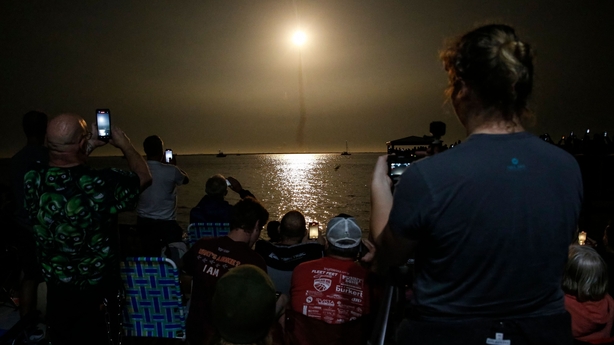NASA launched its new mega Moon rocket from Florida this morning after technical issues had threatened to play spoilsport a third time.
Engineers were forced to temporarily pause the flow of liquid hydrogen into the core stage last night because of a valve leak, though a team sent to the launch pad resolved the problem after an hour.
Later, the space agency reported that a radar monitoring the rocket’s flight path was experiencing problems due to a faulty ethernet switch.
A two-hour launch window opened at 1.04am (6.04 Irish time) and the rocket blasted off at 1.47am local time.
“Lift off of Artemis 1. We rise together. Back to the Moon and beyond,” said a NASA announcer.
We are going.
For the first time, the @NASA_SLS rocket and @NASA_Orion fly together. #Artemis I begins a new chapter in human lunar exploration. pic.twitter.com/vmC64Qgft9
— NASA (@NASA) November 16, 2022
The mission will last 25-and-a-half days, with a splashdown in the Pacific Ocean on 11 December.
The Artemis 1 mission, a test flight without astronauts, represents the first step in America’s plan to build a lasting presence on the Moon and take lessons from there to prepare for a future voyage to Mars in the 2030s.
Named after the sister of Apollo in Greek mythology, the new programme comes 50 years after humans last set foot on lunar soil.
The 32-storey tall Space Launch System rocket is the most powerful ever built.
The takeoff was scheduled less than a week after the passage of Hurricane Nicole, which the rocket weathered on its launch pad.
The space geek inside me is screaming with excitement for tonight. It feels very special to be here for the launch of Artemis I. The most powerful rocket NASA has ever built. It will go further than any spacecraft built for humans, 40k miles past the far side of the moon

pic.twitter.com/zedA2YHKyg
— Laurence Kinlan (@laurencekinlan) November 16, 2022
About 100,000 people had gathered on the coast to watch the launch, among them Irish actor Laurence Kinlan, with the rocket lighting up the night sky.
Andrew Trombley, a space enthusiast from St Louis, Missouri, was anxiously hoping for a successful liftoff after several futile trips made for the launch.
“I’ve been down here a couple of times already to watch this thing go up and have it canceled, so, this is like, whatever, the third trip down here for this, so I’m excited to see it go,” said the network engineer.
“I was too little for the Apollo missions, so … I wanted to be here in person.”
Kerry Warner, 59, a grandmother and semi-retired educator who lives in Florida, is fired up for liftoff, which she said was “part of America and what America is all about”.
“Third time’s the charm. We’re hoping for it.”

Far side of Moon
At the end of September, the rocket had to be wheeled back to its assembly building to be sheltered from another hurricane, Ian.
Before these weather setbacks, two launch attempts were cancelled for technical reasons.
The first failure was related to a faulty sensor, and the second to a fuel leak when filling the rocket’s tanks. It runs on ultra-cold, ultra-volatile liquid oxygen and hydrogen.
NASA has since replaced a seal and modified its procedures to avoid thermal shock as much as possible.
The Orion capsule was lifted by two boosters and four powerful engines under the core stage, which detached after only a few minutes.
After a final push from the upper stage, the capsule was well on its way, taking several days to reach its destination.
Rather than landing on the Moon, it will assume a distant orbit, venturing 64,000km beyond the far side, further than any other habitable spacecraft so far.
Finally, Orion will embark on the return leg of its journey. When passing through the atmosphere, the capsule’s heat shield will need to withstand a temperature half as hot as the Sun’s surface.

NASA is banking on a successful mission after developing the SLS rocket for more than a decade.
It will have invested more than $90bn in its new lunar programme by the end of 2025, according to a public audit.
Artemis 2 will involve a flyby of the Moon with astronauts in 2024.
Boots on the ground should happen during Artemis 3, no sooner than 2025, with the crew set to include the first woman and first person of colour on the Moon.
Lift-off – NASA rocket blasts off for Moon mission
Source: Viral Trends Report


0 Comments